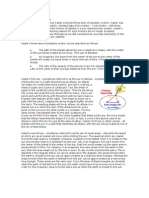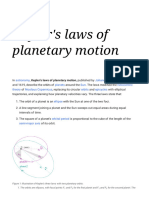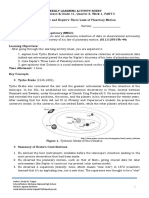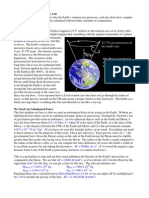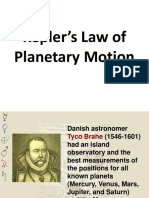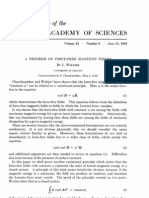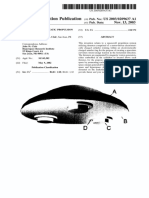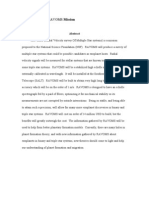Kepler Laws of Planetary Motion
Kepler Laws of Planetary Motion
Uploaded by
clairesantosss12Copyright:
Available Formats
Kepler Laws of Planetary Motion
Kepler Laws of Planetary Motion
Uploaded by
clairesantosss12Original Description:
Original Title
Copyright
Available Formats
Share this document
Did you find this document useful?
Is this content inappropriate?
Copyright:
Available Formats
Kepler Laws of Planetary Motion
Kepler Laws of Planetary Motion
Uploaded by
clairesantosss12Copyright:
Available Formats
Kepler's Three Laws
Kepler's Three Laws
Circular Motion Principles for Satellites
Mathematics of Satellite Motion
Weightlessness in Orbit
Energy Relationships for Satellites
In the early 1600s, Johannes Kepler proposed three laws of planetary motion. Kepler
was able to summarize the carefully collected data of his mentor - Tycho Brahe - with
three statements that described the motion of planets in a sun-centered solar system.
Kepler's efforts to explain the underlying reasons for such motions are no longer
accepted; nonetheless, the actual laws themselves are still considered an accurate
description of the motion of any planet and any satellite.
Kepler's three laws of planetary motion can be described as follows:
The path of the planets about the sun is elliptical in shape, with the center of the
sun being located at one focus. (The Law of Ellipses)
An imaginary line drawn from the center of the sun to the center of the planet will
sweep out equal areas in equal intervals of time. (The Law of Equal Areas)
The ratio of the squares of the periods of any two planets is equal to the ratio of the
cubes of their average distances from the sun. (The Law of Harmonies)
The Law of Ellipses
Kepler's first law - sometimes referred to as the law of ellipses - explains
that planets are orbiting the sun in a path described as an ellipse. An
ellipse can easily be constructed using a pencil, two tacks, a string, a
sheet of paper and a piece of cardboard. Tack the sheet of paper to the
cardboard using the two tacks. Then tie the string into a loop and wrap
the loop around the two tacks. Take your pencil and pull the string until
the pencil and two tacks make a triangle (see diagram at the right). Then
begin to trace out a path with the pencil, keeping the string wrapped
tightly around the tacks. The resulting shape will be an ellipse. An ellipse
is a special curve in which the sum of the distances from every point on
the curve to two other points is a constant. The two other points (represented here by
the tack locations) are known as the foci of the ellipse. The closer together that these
points are, the more closely that the ellipse resembles the shape of a circle. In fact, a
circle is the special case of an ellipse in which the two foci are at the same location.
Kepler's first law is rather simple - all planets orbit the sun in a path that resembles an
ellipse, with the sun being located at one of the foci of that ellipse.
The Law of Equal Areas
Kepler's second law - sometimes referred to as the law of equal areas - describes the
speed at which any given planet will move while orbiting the sun. The speed at which
any planet moves through space is constantly changing. A planet moves fastest when it
is closest to the sun and slowest when it is furthest from the sun. Yet, if an imaginary
line were drawn from the center of the planet to the center of the sun, that line would
sweep out the same area in equal periods of time. For instance, if an imaginary line
were drawn from the earth to the sun, then the area swept out by the line in every 31-
day month would be the same. This is depicted in the diagram below. As can be
observed in the diagram, the areas formed when the earth is closest to the sun can be
approximated as a wide but short triangle; whereas the areas formed when the earth is
farthest from the sun can be approximated as a narrow but long triangle. These areas
are the same size. Since the base of these triangles are shortest when the earth is
farthest from the sun, the earth would have to be moving more slowly in order for this
imaginary area to be the same size as when the earth is closest to the sun.
The Law of Harmonies
Kepler's third law - sometimes referred to as the law of harmonies - compares the
orbital period and radius of orbit of a planet to those of other planets. Unlike Kepler's
first and second laws that describe the motion characteristics of a single planet, the
third law makes a comparison between the motion characteristics of different planets.
The comparison being made is that the ratio of the squares of the periods to the cubes
of their average distances from the sun is the same for every one of the planets. As an
illustration, consider the orbital period and average distance from sun (orbital radius)
for Earth and mars as given in the table below.
Period Average T2/R3
Planet
(s) Distance (m) (s2/m3)
Earth 3.156 x 107 s 1.4957 x 1011 2.977 x 10-19
Mars 5.93 x 107 s 2.278 x 1011 2.975 x 10-19
Observe that the T2/R3 ratio is the same for Earth as it is for mars. In fact, if the
same T2/R3 ratio is computed for the other planets, it can be found that this ratio is
nearly the same value for all the planets (see table below). Amazingly, every planet has
the same T2/R3 ratio.
Planet Period Average T2/R3
(yr) Distance (au) (yr2/au3)
Mercury 0.241 0.39 0.98
Venus .615 0.72 1.01
Earth 1.00 1.00 1.00
Mars 1.88 1.52 1.01
Jupiter 11.8 5.20 0.99
Saturn 29.5 9.54 1.00
Uranus 84.0 19.18 1.00
Neptune 165 30.06 1.00
Pluto 248 39.44 1.00
(NOTE: The average distance value is given in astronomical units where 1 a.u. is equal
to the distance from the earth to the sun - 1.4957 x 10 11 m. The orbital period is given
in units of earth-years where 1 earth year is the time required for the earth to orbit the
sun - 3.156 x 107 seconds. )
Kepler's third law provides an accurate description of the period and distance for a
planet's orbits about the sun. Additionally, the same law that describes the T2/R3 ratio
for the planets' orbits about the sun also accurately describes the T2/R3 ratio for any
satellite (whether a moon or a man-made satellite) about any planet. There is
something much deeper to be found in this T2/R3 ratio - something that must relate to
basic fundamental principles of motion. In the next part of Lesson 4, these principles
will be investigated as we draw a connection between the circular motion principles
discussed in Lesson 1 and the motion of a satellite.
How did Newton Extend His Notion of Gravity to Explain
Planetary Motion?
Newton's comparison of the acceleration of the moon to the acceleration of objects on
earth allowed him to establish that the moon is held in a circular orbit by the force of
gravity - a force that is inversely dependent upon the distance between the two objects'
centers. Establishing gravity as the cause of the moon's orbit does not necessarily
establish that gravity is the cause of the planet's orbits. How then did Newton provide
credible evidence that the force of gravity is meets the centripetal force requirement for
the elliptical motion of planets?
Recall from earlier in Lesson 3 that Johannes Kepler proposed three laws of planetary
motion. His Law of Harmonies suggested that the ratio of the period of orbit squared
(T2) to the mean radius of orbit cubed (R3) is the same value k for all the planets that
orbit the sun. Known data for the orbiting planets suggested the following average
ratio:
k = 2.97 x 10-19 s2/m3 = (T2)/(R3)
Newton was able to combine the law of universal gravitation with circular motion
principles to show that if the force of gravity provides the centripetal force for the
planets' nearly circular orbits, then a value of 2.97 x 10-19 s2/m3 could be predicted for
the T2/R3 ratio. Here is the reasoning employed by Newton:
Consider a planet with mass Mplanet to orbit in nearly circular motion about the sun of
mass MSun. The net centripetal force acting upon this orbiting planet is given by the
relationship
Fnet = (Mplanet * v2) / R
This net centripetal force is the result of the gravitational force that attracts the planet
towards the sun, and can be represented as
Fgrav = (G* Mplanet * MSun ) / R2
Since Fgrav = Fnet, the above expressions for centripetal force and gravitational force are
equal. Thus,
(Mplanet * v2) / R = (G* Mplanet * MSun ) / R2
Since the velocity of an object in nearly circular orbit can be approximated as v =
(2*pi*R) / T,
v2 = (4 * pi2 * R2) / T2
Substitution of the expression for v2 into the equation above yields,
(Mplanet * 4 * pi2 * R2) / (R • T2) = (G* Mplanet * MSun ) / R2
By cross-multiplication and simplification, the equation can be transformed into
T2 / R3 = (Mplanet * 4 * pi2) / (G* Mplanet * MSun )
The mass of the planet can then be canceled from the numerator and the denominator
of the equation's right-side, yielding
T2 / R3 = (4 * pi2) / (G * MSun )
The right side of the above equation will be the same value for every planet regardless
of the planet's mass. Subsequently, it is reasonable that the T2/R3 ratio would be the
same value for all planets if the force that holds the planets in their orbits is the force of
gravity. Newton's universal law of gravitation predicts results that were consistent with
known planetary data and provided a theoretical explanation for Kepler's Law of
Harmonies.
Investigate!
Scientists know much more about the planets than they did in Kepler's days. Use The
Planets widget bleow to explore what is known of the various planets.
You might also like
- Satellite Orbital MechanicsDocument29 pagesSatellite Orbital MechanicsmojammeljoyNo ratings yet
- PHYS122 University of WaterlooDocument174 pagesPHYS122 University of WaterlooEddy LiuNo ratings yet
- 4 Kepler LabDocument4 pages4 Kepler LabJovie MedsNo ratings yet
- CapricornDocument7 pagesCapricornSambuddha SarkarNo ratings yet
- A Practice GuideDocument113 pagesA Practice GuideSalvador Latorre Peña100% (11)
- Coordination (Linguistics) - Wikipedia, The Free Encyclopedia - HTMLDocument9 pagesCoordination (Linguistics) - Wikipedia, The Free Encyclopedia - HTMLalolapukaNo ratings yet
- KeplerDocument8 pagesKepleracire joNo ratings yet
- Keppler's Laws of MotionDocument4 pagesKeppler's Laws of Motionbittu692No ratings yet
- Kepler's LawsDocument18 pagesKepler's LawsMariana PaivaNo ratings yet
- Motion of Planet and Kepler's LawDocument4 pagesMotion of Planet and Kepler's LawArslan RajaNo ratings yet
- The Three Laws of KeplerDocument2 pagesThe Three Laws of KeplerSantoshNo ratings yet
- Planetary and Satellite MotionDocument3 pagesPlanetary and Satellite MotionFaris Izzuddin RoslinNo ratings yet
- Physics ProjectDocument58 pagesPhysics ProjectNavneet100% (3)
- Kepplers Laws of Motion & Other NotesDocument35 pagesKepplers Laws of Motion & Other NotesPriyanshu JaisalNo ratings yet
- Kepler's Laws of Planetary Motion - Wikipedia, The Free EncyclopediaDocument15 pagesKepler's Laws of Planetary Motion - Wikipedia, The Free EncyclopediaSandiyoNo ratings yet
- GRAVITATION Tuition Notes-Converted - 240909 - 130518Document8 pagesGRAVITATION Tuition Notes-Converted - 240909 - 130518yogesh.patle1997No ratings yet
- How Kepler'S Laws Contradicted Uniform Circular MotionDocument6 pagesHow Kepler'S Laws Contradicted Uniform Circular MotionerfghnmNo ratings yet
- Kepler Law From NettDocument7 pagesKepler Law From NettIndah Septia NingsihNo ratings yet
- Kepler's Laws and Planetary Motion: Answer: BDocument2 pagesKepler's Laws and Planetary Motion: Answer: BAnthony QuanNo ratings yet
- tmpF8EF TMPDocument8 pagestmpF8EF TMPFrontiersNo ratings yet
- Physics Investigatory ProjectDocument7 pagesPhysics Investigatory ProjectviiiadivyanshkumarNo ratings yet
- Keplers LawDocument2 pagesKeplers LawDaniela EdilloNo ratings yet
- Kaplar's Law of Planetary SystemDocument2 pagesKaplar's Law of Planetary SystemMuhammad Bilal MalikNo ratings yet
- Kepler's Laws of Planetary Motion: UNIT-1Document17 pagesKepler's Laws of Planetary Motion: UNIT-1Sunil PatelNo ratings yet
- Kepler's Laws of Planetary MotionDocument26 pagesKepler's Laws of Planetary MotionReymark CasintoNo ratings yet
- Harmonic Esmund IDocument5 pagesHarmonic Esmund IRajender SalujaNo ratings yet
- Topic 6 - Satellite Communications SystemsDocument82 pagesTopic 6 - Satellite Communications SystemsJaiko BendoNo ratings yet
- Harmonices MundiDocument3 pagesHarmonices Mundiali276179aliNo ratings yet
- Kepler S Laws of Planetary 1Document14 pagesKepler S Laws of Planetary 1AJAY KUMARNo ratings yet
- Introduction Orb MechanicsDocument9 pagesIntroduction Orb MechanicsParag MahajaniNo ratings yet
- Tmpe436 TMPDocument8 pagesTmpe436 TMPFrontiersNo ratings yet
- KeplarDocument10 pagesKeplarprashant94No ratings yet
- Orbits and Kepler's Laws: Gravitational ForceDocument6 pagesOrbits and Kepler's Laws: Gravitational ForceDavid Gonzalez ArjonaNo ratings yet
- tmp7CFA TMPDocument6 pagestmp7CFA TMPFrontiersNo ratings yet
- Pusat Tuition Makrifat Chapter 3.3 F.4.PhyDocument5 pagesPusat Tuition Makrifat Chapter 3.3 F.4.PhyBazil BoliaNo ratings yet
- Kepler's Laws of Planetary Motion: Central ForceDocument14 pagesKepler's Laws of Planetary Motion: Central ForceSouhardya SenNo ratings yet
- Universal GravitationalDocument17 pagesUniversal GravitationalaftabNo ratings yet
- BASIC Ideas StarsDocument5 pagesBASIC Ideas StarsAnup Bhushan Sneha SuralkarNo ratings yet
- Keplers LawsDocument6 pagesKeplers LawsPulkit SharmaNo ratings yet
- The Earth in The Solar SystemDocument27 pagesThe Earth in The Solar SystemsnarendranathNo ratings yet
- Paramahamsa Tewari - On Planetary Motion Caused by Solar Space VortexDocument9 pagesParamahamsa Tewari - On Planetary Motion Caused by Solar Space VortexKluff5878No ratings yet
- On Planetary Motion Caused by Solar Space-VortexDocument9 pagesOn Planetary Motion Caused by Solar Space-VortexAni VinNo ratings yet
- Assignment On AstrophysicsDocument5 pagesAssignment On AstrophysicsNarayanan Elatchoumy PadyNo ratings yet
- Solar MassDocument4 pagesSolar MassbeautilinNo ratings yet
- Lesson 35: Kepler's Three Laws of Planetary MotionDocument6 pagesLesson 35: Kepler's Three Laws of Planetary MotionMohamed AtieaNo ratings yet
- A Simple Explicit Model: Short Term Planetary OrbitsDocument7 pagesA Simple Explicit Model: Short Term Planetary Orbitsbrown0No ratings yet
- Author: Emely M. Tragua School/Station: Kitcharao National High School Division: Agusan Del Norte Email Address:emely - Tragua001@deped - Gov.phDocument6 pagesAuthor: Emely M. Tragua School/Station: Kitcharao National High School Division: Agusan Del Norte Email Address:emely - Tragua001@deped - Gov.phShekaina Faith Cuizon Lozada100% (2)
- Precession of The EarthDocument3 pagesPrecession of The EarthsniffscurryNo ratings yet
- LectureDocument23 pagesLectureKenn SenadosNo ratings yet
- Numerical Experience With The Three-Body Problem 1Document7 pagesNumerical Experience With The Three-Body Problem 1Maiman LatoNo ratings yet
- Project in ScienceDocument9 pagesProject in SciencePaul Michael FermaNo ratings yet
- Gravity Lecture NotesDocument3 pagesGravity Lecture Notescmckain15No ratings yet
- Kepler's Law of Planetary MotionDocument13 pagesKepler's Law of Planetary MotionShainah Mae GomezNo ratings yet
- Kepler's Laws - 1Document3 pagesKepler's Laws - 1Monika JindalNo ratings yet
- New Concepts in GravitationDocument13 pagesNew Concepts in GravitationAce Ralph100% (1)
- Introduction To Satellite Communication:: Unit I Satellite OrbitsDocument22 pagesIntroduction To Satellite Communication:: Unit I Satellite OrbitsjagadishNo ratings yet
- Celestial MechanicsDocument8 pagesCelestial MechanicsRuvy Caroro Legara DenilaNo ratings yet
- GFFGHFDocument20 pagesGFFGHFAlbano SaliNo ratings yet
- Newton's "Derivation" of The Inverse Square Law of GravityDocument7 pagesNewton's "Derivation" of The Inverse Square Law of GravityIrtizahussainNo ratings yet
- Theories of MotionDocument9 pagesTheories of MotionHarould MaderaNo ratings yet
- L. Woltjer - A Theorem On Force-Free Magnetic FieldsDocument3 pagesL. Woltjer - A Theorem On Force-Free Magnetic FieldsPlamcfeNo ratings yet
- Topology Without Tears - SIDNEY A. MORRISDocument236 pagesTopology Without Tears - SIDNEY A. MORRISzbanach_tarski100% (1)
- QuantummethnfslfpjgDocument152 pagesQuantummethnfslfpjgMary Grace Magpayo LanwangNo ratings yet
- Derivation of The Fokker Planck EquationDocument6 pagesDerivation of The Fokker Planck Equation_nimbleNo ratings yet
- Final Call - Main Essay CompilationDocument134 pagesFinal Call - Main Essay CompilationAlex KochkinNo ratings yet
- Auguste Comte: Law of Three Stages, Theory of Human Intellectual DevelopmentDocument2 pagesAuguste Comte: Law of Three Stages, Theory of Human Intellectual DevelopmentirfanNo ratings yet
- Planets, Luminaries, Asteroids, and Points in AstrologyDocument3 pagesPlanets, Luminaries, Asteroids, and Points in AstrologySushant ChhotrayNo ratings yet
- Stability Chapter 01Document15 pagesStability Chapter 01Fabio IannoneNo ratings yet
- KP EZine - 120 - January - 2017 PDFDocument43 pagesKP EZine - 120 - January - 2017 PDFKALSHUBH50% (2)
- 1652 Ashmole Theatrum Chemicum BritannicumDocument8 pages1652 Ashmole Theatrum Chemicum BritannicumJody BruceNo ratings yet
- Ket Exam 3 ReadingDocument10 pagesKet Exam 3 ReadingFranciscaBalasSuarezNo ratings yet
- The Continental Shift Theory and WenegerDocument6 pagesThe Continental Shift Theory and WenegersiddiqueaquibNo ratings yet
- Theurgy in The Medieval Islamic WorldDocument109 pagesTheurgy in The Medieval Islamic WorldIan Thomson100% (8)
- Science5 Q4 Module6 Week6 24pDocument24 pagesScience5 Q4 Module6 Week6 24praymondcapeNo ratings yet
- Soal Uas B Inggris Kls 11 SM 1Document8 pagesSoal Uas B Inggris Kls 11 SM 1Kirigaya HideyoshiNo ratings yet
- Logic and Set TheoryDocument54 pagesLogic and Set TheoryMatthew GreenNo ratings yet
- Literacy: Thrust Lift Air Resistance Friction Gravity Upthrust WeightDocument3 pagesLiteracy: Thrust Lift Air Resistance Friction Gravity Upthrust WeightJonathan Wilmshurst100% (1)
- (ARCHIVED) 6734 - 01 - Rms - 20080807Document11 pages(ARCHIVED) 6734 - 01 - Rms - 20080807Vandana JainNo ratings yet
- Physical Science Module 1 EditedDocument22 pagesPhysical Science Module 1 EditedLela GenNo ratings yet
- Human Resource Management Based On The Index of Islamic Human DevelopmentDocument13 pagesHuman Resource Management Based On The Index of Islamic Human DevelopmentpertiwidwianugrahNo ratings yet
- RAVOMS ProposalDocument6 pagesRAVOMS ProposalCarl TannlerNo ratings yet
- Simulation of Simple PendulumDocument6 pagesSimulation of Simple PenduluminventionjournalsNo ratings yet
- Edward Witten Ponders The Nature of RealityDocument17 pagesEdward Witten Ponders The Nature of Realityeldelmoño luciNo ratings yet
- EBOOK Ebook PDF Universe Solar System Stars and Galaxies 8Th Edition Download Full Chapter PDF KindleDocument61 pagesEBOOK Ebook PDF Universe Solar System Stars and Galaxies 8Th Edition Download Full Chapter PDF Kindlefletcher.edrington262100% (47)
- A New Cosmogony On The Origin of The UniverseDocument10 pagesA New Cosmogony On The Origin of The UniverseD'Vinci Fradique BragaNo ratings yet
- Representing Water: Visual Anthropology and Divergent Trajectories in Human Environmental RelationsDocument31 pagesRepresenting Water: Visual Anthropology and Divergent Trajectories in Human Environmental RelationsGustavo ValdiviaNo ratings yet









